|
|
|
|
| Commune |
|
Beaulieu-Lés-Loches
Bueil-en-Touraine
Candes-Saint-Martin Chinon
Loche Montrésor
Saint-Paterne-Racan
Rivière
Tavant
Tours Ussé |
| |
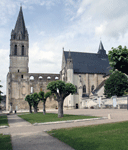 |
Beaulieu-Lés-Loches |
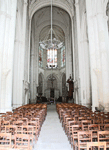 |
| Fulk
Nerra, Count of Anjou, founded a Benedictine monastery
here in 1007. The church was destroyed and rebuilt many times;
the western part is in a semi-ruinous state but the east is
restored and now the parish church. He died in 1040 and on the
left is his coffin lid, set under glass below the church's
modern floor. A later effigy, now lost, may have existed. |
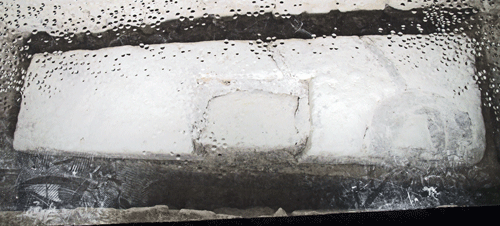
|
| Something
about Fulk the Black |
Fulk III, Count of Anjou - known in Old
French as Foulque Nerra - (972-1040) was a fearsome
warrior and a great builder of castles and abbeys His daughter
was Emingarde mother of Fulk IV, Count of Anjou - known as
Foulque Réchin - (1095-1109); so the County of Anjou could pass
through the female line. This Fulk was father of Fulk V who
became King of Jerusalem and grandfather of King Henry II of
England.
|
|
 |
Bueil - en - Touraine
Parish Church of St-Pierre-aux-Liens
/
Collegiate Church of St-Michel-et-Sts-Innocents |
.png) |
.png) |
Very welcoming churches, open normal hours: one connects to the other. Well signposted.
Park in village, which is well worth a detour.
The parish church is linked via a door (seen in first photograph on the
right) to the collegiate church, which was built to contain the tombs of
the lords of Bueil. . The four effigies lie in niches in the wall,
three of which can be seen in the second photograph on the right
Ref: 47° 38.7' N / 0° 33.1'
E |
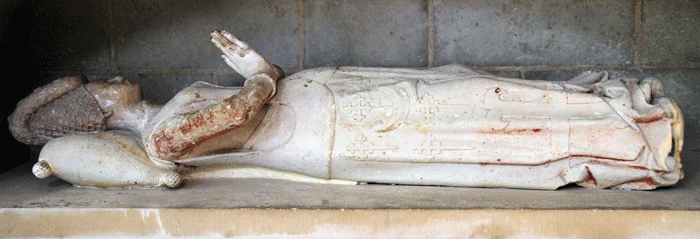 |
 |
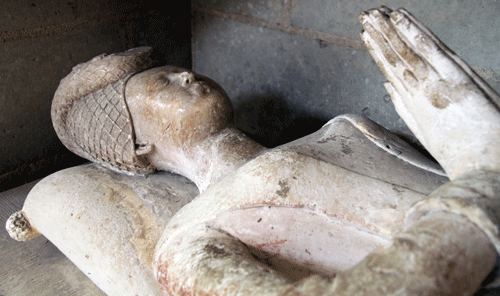 |
 |
|
Jeanne de Montejean
(1459), 1st Wife of Jean V de Bueil.
(ref:: 303/XVIII; p.122;pl.56). Note
her head dress and arms in relief carved on her gown |
|
Marguerite de la
Chausade (1443) &
below Pierre de
Bueil (1414) These effigies were
originally side by side on a tomb chest, now
destroyed. |
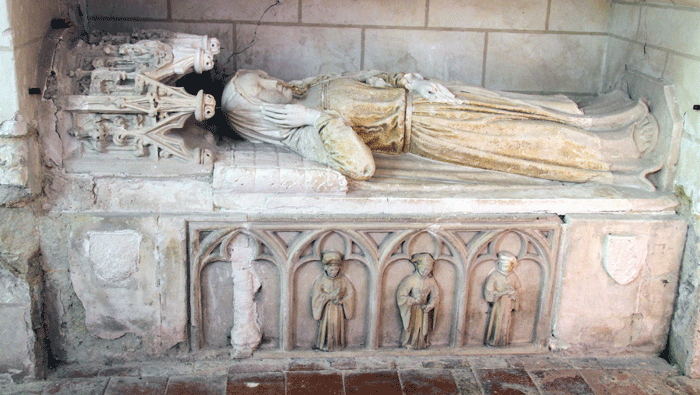 |

| Martine Turpin,
2nd Wife of Jean V de Bueil. This effigy was
originally in the now destroyed chapel of the
nearby château of Plessis-Barte and moved here
in 1850. Note the gablette, the unusual position of the arms, long hair and
seemingly bare feet, although in fact she is wearing
sandals. Her feet also rest on a plinth rather than the
usual dog. |
|
|
 |
Candes-St-Martin |
 |
| St Martin - a Roman soldier who converted
to Christianity - founded a church here and later became Bishop
of Tours; he died here in 397 and was buried in his cathedral,
after the monks of that place stole his body from
Candes-Saint-Martin. The present church is 12th -15th century.
This is a beautiful village lying on the confluence of the
Vienne and the Loire rivers and well worth a visit. The
collegiate church is also well worth seeing with its magnifivent
porch and high vaulting. |
.png) |
.png) |
St Martin is said to have died in what is
now St Martin's Chapel at the North-East end of the church. But
he wasn't to be buried there as the monks from Tours stole his
body for burial in their church and there it remains. This
effigy. under the altar of the chapel named after shows
him as a simple monk lying on stones probably showing him on his
death bed..
|
There is another effigy between the
chapel and the chancel. This one shows St Martin in his bishop's
finery and lies on a tomb chest. Both of these effigies are mid
19th century
|
|
|
Chinon - Chapelle Sainte-Radegond |
Although Chinon is a worthwhile town to visit, has an excellent
castle and several churches, as well as being an important town
in the middle ages, it is remarkably poor in church monuments.
There is only one and that is a walk from the town centre.
This chapel is cut into the rock face and
is quite a long, hard walk along a track going steeply uphill from the
old town, with a not picturesque view of the new town below. The
chapel contains the 19th century cenotaph and effigy
of Jean de Chinon, also called Jean de Moûtler
or Jean le Recluse (6th century). Of special interest
are the medieval wall paintings. Wear sensible shoes! Opening
times are limited so it is best to check with the tourist
office.. There is an entrance fee of €3.00 (2019). Free parking
on the edge of town near the castle from where the old town can been
reached by a lift if the steep walk down deters you.
|
Easter - June 30th and September:
Saturdays, Sundays and Bank Holidays only, 3.00pm-6.00pm
July and August: Daily - except Tuesdays -
3.00pm-6.00pm
|
|

|

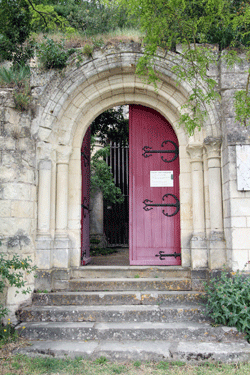
The effigy looks almost the same as that
of St Martin in Candes-Saint-Martin, so almost certainly made at
the same time and by the same studio. |
 |
|
 |
Langeais |
 |
| A 15th century stone effigy of unknown type
is reported here by The List but I have been unable to find it.
However the List does contain errors from time to time. It is not in
the central church of St-Jean-Baptiste (open during
normal hours), unless it is in the locked crypt. (Left).
There is no mention
of an effigy in Les Églises de France
but this series does not always give much prominence to
effigies.There is another church a short walk from the town centre -
church of St Laurent, but this is locked and I was not
able to gain entry. (Right) Nor have I been able to
discover further details of this church. Free parking in the
town. For the moment this is non proven until further
information is received. |
|
 |
Loches
- Collegiate Church of St Ours |
 |
Church open during normal hours follow the signs to the Church or
Logis Royal or
Chȃteau not
the nearby Donjon.
Parking nearby is free. Well
worth a visit not only to see this beautiful effigy but also the town itself.
Please note that the monument was, although originally in the church,
for a long period in the Logis Royal until being moved in recent times
back into the church; some guide books may give an incorrect location.
Ref: 47° 08' N / 1° 00' E |
 |
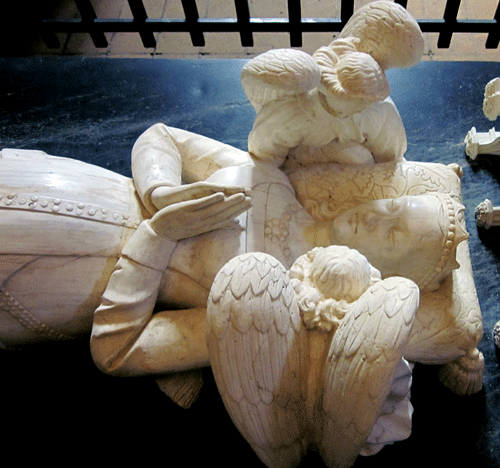 |
 |
The beautiful effigy of
Agnes Sorel, mistress
of Charles VII (Joan of Arc's Dauphin) has now been returned to the
church where it was originally situated, having been for many years
housed in the nearby Logis Royal. She died at the early age of
twenty-right and a portrait of her, with one breast bare, may been seen
in that latter building. Note that her feet rest on two lambs, a
rebus of her Christian name;
agneau
being French for
lamb.
For details of Agnes's
recently examined skeleton click
here.
Some of the above photographs were taken in
the Logis while others were taken in the church,
where the effigy is slightly less accessible. You will notice
that the base on which the effigy lies has been replaced and a gablet added to the
monument. |
|
 |
Montrésor -
Collégiale Saint-Jean-Baptist |
 |
The church was built in the middle of the 16th C, being
consecrated in 1532, by Ymbert de Bastarnay, Lord of Montrésor,
as a family mausoleum. The monument we see today is of
Ymbert de Bastarnay (1523), his wife Georgette
de Monchenu (1511) and their son François
(1513). It
originally stood over the burial vault in the centre of the church but was
broken and
ejected during the French Revolution in 1793; the church was
restored in 1875 when the reassembled monument was resited
at the west end of the church, now the parish church. The
resoration of the alabaster monument was under the direction of
Parisian architect Fransçois Roguet and by the sculptor Michel
Brueil. The original parish church is nearby and now a private
house.
The church is open during daylight hours and parking is free in
the street nearby. Ref: 47° 09' N / 1° 12' E |
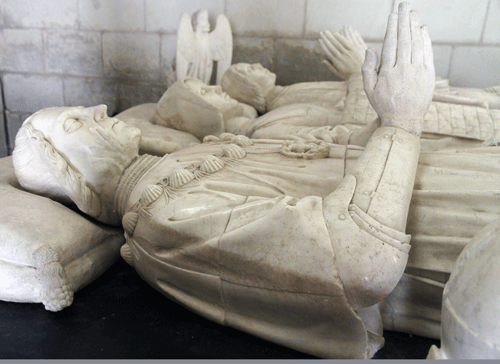 |
 |
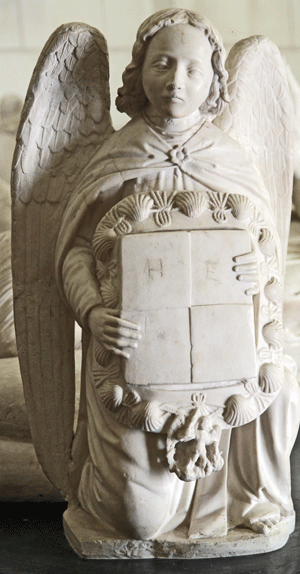 |
|
Ymbert de Bastarnay (1523), his wife Georgette
de Monchenu (1511) and their son François
(1513) |
|
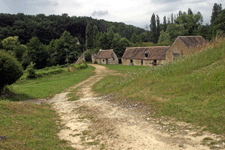 |
St-Paterne-Racan
Abbaye de la Clarté Dieu |
.png) |
A tourist information board in
Buile-en-Touraine promised that there was a very fine
military effigy here, supposed to be that of
Jehane d'Alluye
(1248). We drove out to the abbey where a notice on one of the entrance
gate posts stated 'Private Property' and one on the
other was the telephone number to arrange visits,
but this no longer functioned. However, wandering in, we
received a very warm welcome from the owners. There is very
little remaining above ground of the actual church but much of
some of the conventual buildings remain and some of these are
used for exhibitions. The promised military effigy is now
permanently on display in the Cloisters Museum, New York.
Ref: 47°
36' N / 0° 28' E |
.png) |
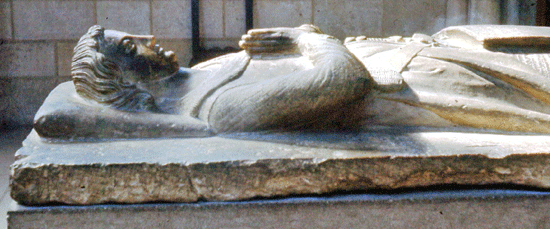 |
| We were shown this incised slab which
is unfortunately fractured and defaced. The feet of a military
effigy can just be made out and there are remains of an
inscription. The effigy also appears to have been surrounded by
a canopy. |
Several years later and quite by chance CMS
colleague Tony Carr sent me this photograph of the very effigy
that he had photographed in the Cloisters Museum on a vist to
New York. Th head by the looks of it has been completely
replaced. |
|
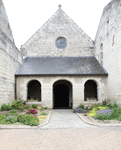 |
Rivière
- Église Notre-Dame |
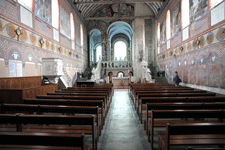 |
The church and the
village on the banks of the Vienne are well worth a visit: a
short detour from the road between Chinon and Loche. The church
is unusual, being almost completely surrounded by buildings;
however there is a court yard in from of the west end of the
church with free parking. The church is open daily during
daylight hours. In the 19th century the church interior was
painted in what was beloved to be a medieval fashion; this is
quite effective and very pleasant. The monuments are in the
crypt.
Ref: 47° 09' N / 0° 17' E |
| Above: Unknown knight and lady, limestone,
16th century Also: Incised slab which can just be seen at
the base of the tomb chest, to the left. It reads: 'Dame
De Bacher who died 12th April 1683' |
|
 |
Tavant -
Church of St-Nicholas |
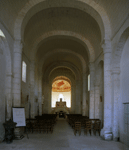 |
There is a small free car park near the
church. The opening hours are restricted (see below); entry is
free but there is a small charge (€3.00 - 2012) for regular guided tours of the
crypt to see the medieval wall
paintings. The effigy, however, is in the north
transept. Ref: 47° 07' N / 0° 23'
E
| The church is open from 10.00 am-12.30 pm
and 2.15 pm-6.00 pm on the following days: |
April to September
March, October and November
December and January
February |
From Wednesday to Sunday
From Monday to Friday
Possible to visit Monday to Thursday
Closed |
| It is advisable to check these
somewhat complicated opening times (which are posted on
the church door) at the town hall or possibly the
tourist office in Chinon |
|
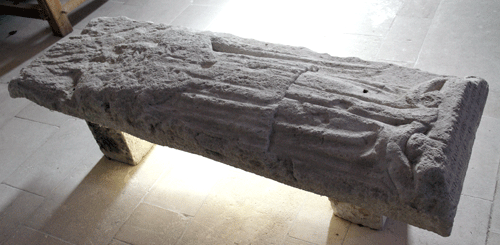 |
 |
| Jehan de Guydier (1564),
Curé of Tavant. The effigy was found in
the church yard and has been sited in the church since 1970. The
inscription reads: 'CI GIT VENERABLE ET DISCRET [illegible] SIRE
JEHAN GUYDIER CURE DE TAVA... TRESPASSA LE XX JOUR DE MARS
15[6]4' |
|
| City of Tours |
| There's an excellent train service from Paris; I have not tried parking
here but probably similar to Angers. I always find Tours is full of shoe
shops and opticians. |
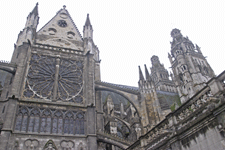 |
The Cathedral
of St Gatianus |
Entrance is free and no charge for photography.
There is a very fine early
Renaissance monument to two young children of
King Charles VIII and a series of monuments to
19th and 20th century archbishops but the
magnificent architect is the best feature here.
Ref: 47°
24' N / 0° 42' E |
 |
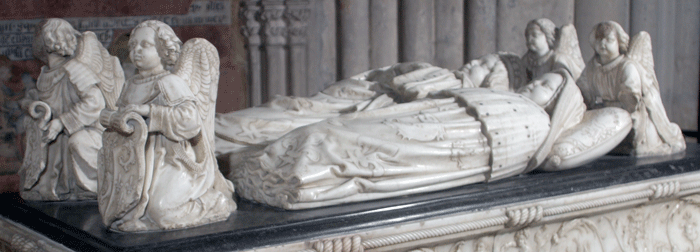 |
|
Children of Charles VIII & Anne
of Brittany: Charles-Orland (1492-1495)
and Charles (1496). Note the baby and
young child. Carrera marble by
Jérôme de Fiésole. Italian style
but the effigies are in the Medieval
tradition of Michel Colombe. The
monument was in the Basilica of St
Martin from 1506 and moved to the
Cathedral in 1834. |
 |
 |
Charles-Théodore Colet (1883)
By architect
Marcel Lambert and sculptors
Pierre
Damien and
Louis Nöel.
CI GIT CHARLES THEODORE
COLET, ARCHEVEQUE DE LUCHON PUIS DE TOURS, MORTE LE 19 NOVENBRE
1883 A L'AGE 77 ANS
Archbishop of Tours 1874-1883 |
René François Renou (1913) By
sculptor Georges Delperier.
HIC QUIESCAT IN D[OMIN]O PATER D D RENATUS FRANCISCUS RENOU
QUI BURGOLII NATUS VITAM CARITATE REFERTAM COMPLEVIT PATRIAE
BENEMERITUS EPISCOPUS AMBIANESIS ANNIS III DEHIND ARCHIEPISCOPUS
TURONENSIS SOLIO PONTIFICIO ASSISTENS POST ANNOS XVII LABORE
FRACTUS ONUS DEPOSUIT VI SUPERSTAS OBIIT KAL MARTII MCMXX
AETSTIS SUAE LXXVI CLERUS POPULUSQUE DIOCESIS TURON[UM] GRATI
POSUERE
Archbishop of Tours 1896-1913 |
 |
 |
 |
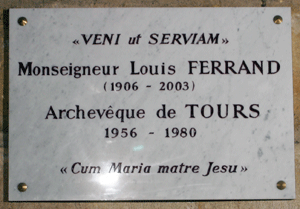 |
Felix Pierre Fruchard (1874)
Archbishop of Tours 1871-1874 |
Louis Ferrand (1980)
Archbishop of Tours 1956-1960
|
Albert Negre (1931)
Archbishop of Tours 1913 - 1931 |
 |
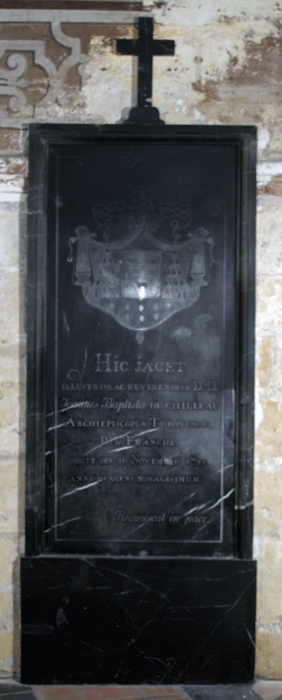 |
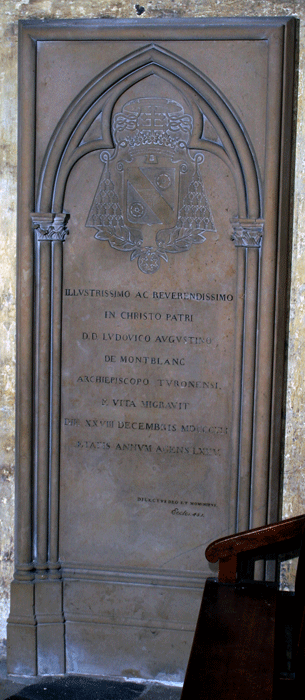 |
|
Michel-Jean Amelot (1724)
Diplomat; Conseillier d'Etat to
Louis IV. He was the nephew of
Archbishop Michel Amelot de Gournay |
Jean-Baptiste du Chilleau (1824)
Archbishop of Tours 1818-1824 |
Augustin Louis de Montblanc (1841)
Archbishop of Tours 1824-1841 |
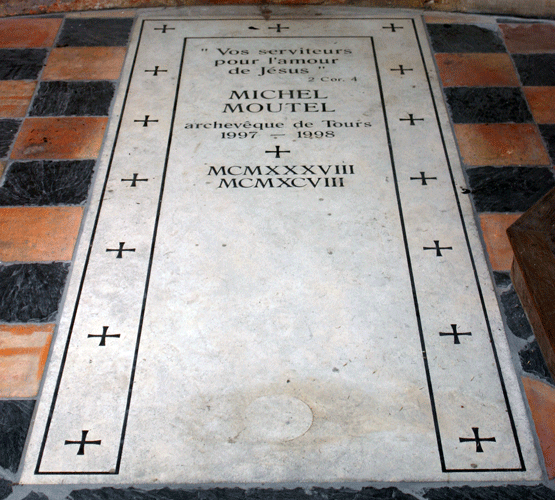 |
 |
Michel Moutel (1998)
Archbishop of Tours
1997-1998 |
Ludovic Gaillard (1956)
Archbishop of Tours
1931-1956 |
 |
Basilica of St Martin
|
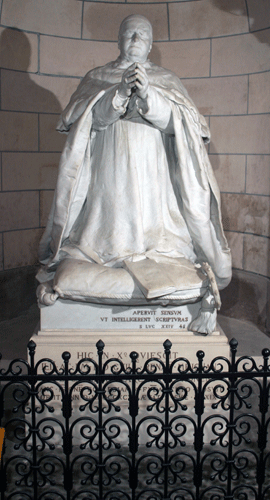 |
|
Ref: 47°
23' N / 0° 41' E |
 |
| There have been several
churches on this site over the grave of St
Martin. Only towers of the medieval church now
remain, other parts of the building having been
demolished in the Revolution and later. A new
Neo-Bazantine basilica was erected over the
grave of St Martin 1888-1924 by
Guillaune René Meigan, Archbishop of
Tours, whose monument in the crypt is shown
to the right. Above is the structure built over St
Martin's grave, also in the crypt. |
|
|
Ussé - Château
of Ussé |
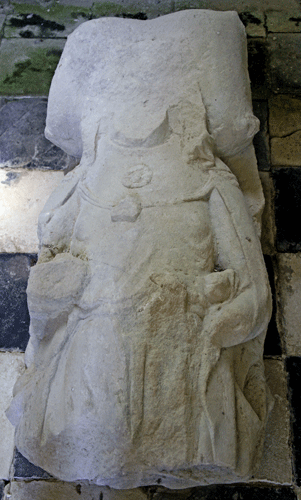 |
This 15th century effigy of an unknown lady was
originally in the Abbey of Turpeny but is now housed in the
private chapel of the Chȃteau
of Ussé.
Parking in the village is free and you may visit the chȃteau
- which is privately owned - as well as the chapel in the
grounds but the cost is relatively high. Nothing else is
mentioned about this effigy
|
|
|
| <Top of Page>
<Centre - Index> <Home
- Index Page> |
| |

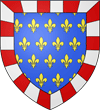








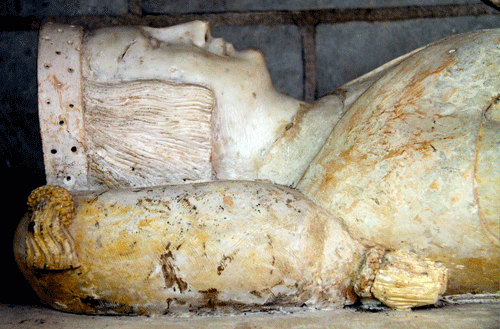
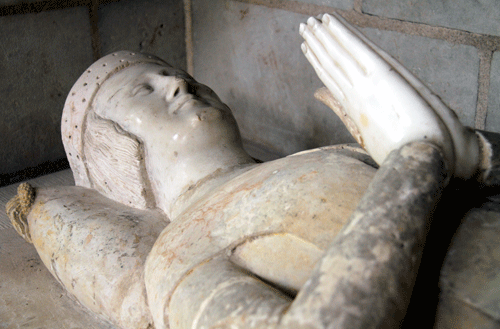



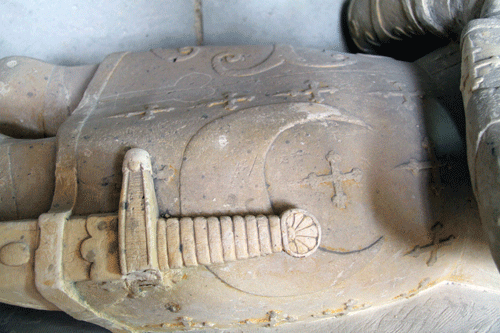



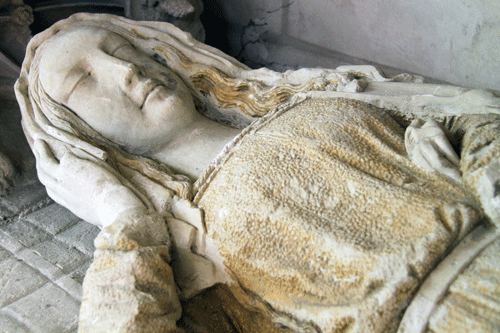

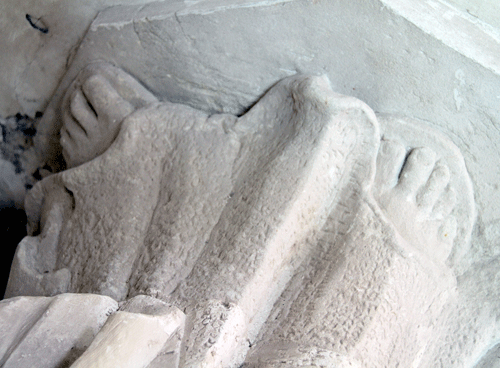


.png)
.png)








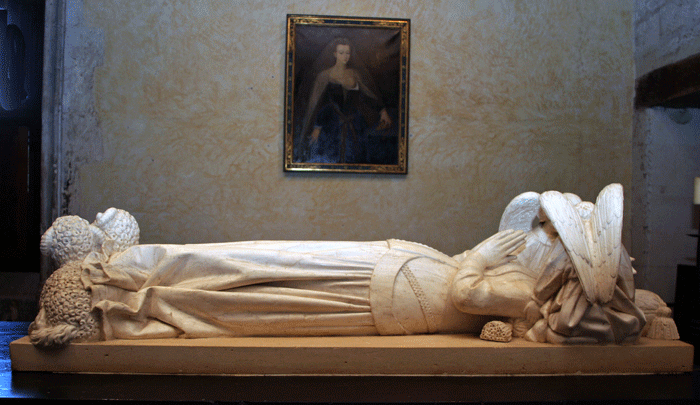









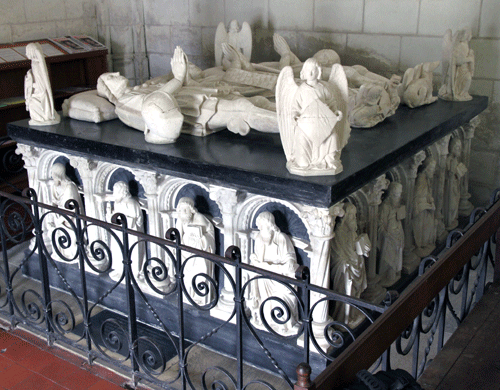
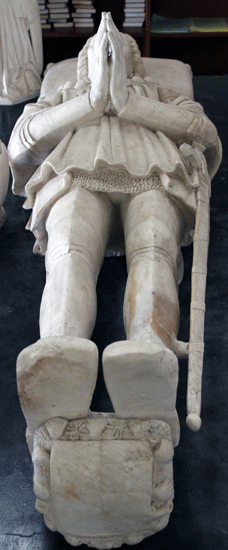
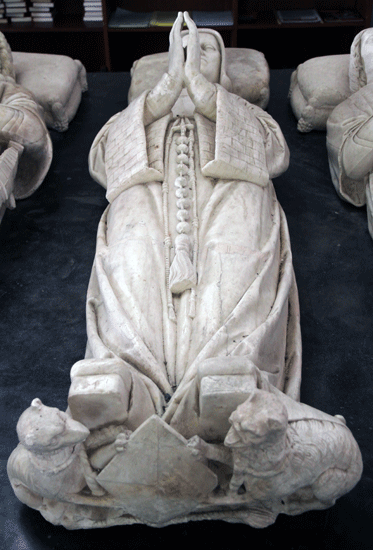
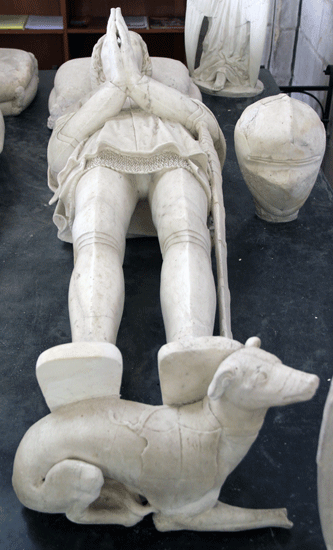




.png)
.png)



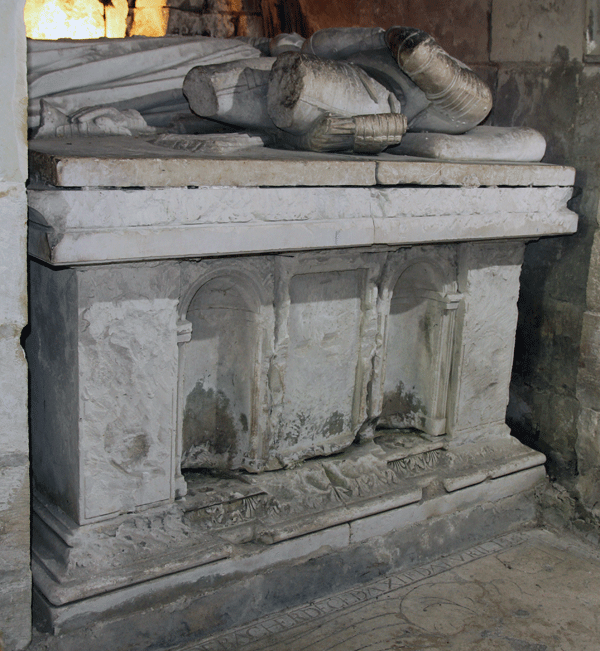

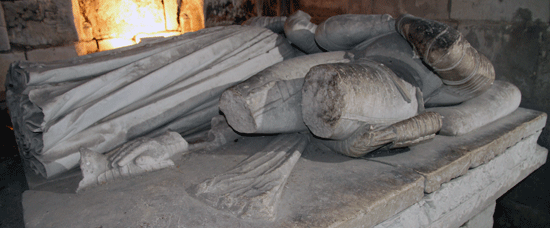
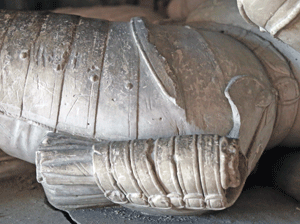


























.png)
.png)